Financial Analysis of Tesco PLC: Expansion, Budgeting, and Planning
VerifiedAdded on 2020/01/07
|16
|3874
|166
Report
AI Summary
This report provides a comprehensive financial analysis of Tesco PLC, addressing key aspects of financial management in the context of a planned expansion. The analysis begins with an examination of various sources of finance available to Tesco, evaluating their suitability for the company's needs, including factoring, overdrafts, bank loans, debentures, and shares, along with the implications of each. The report then delves into the impact of different financing options, such as debentures and share issues, on financial statements, considering their effects on the profit and loss account and balance sheet. The importance of financial budgeting and planning is highlighted, along with the information needs of different decision-makers, such as investors and suppliers. The report includes a calculation of variances and an analysis of capital budgeting techniques, including payback period, accounting rate of return (ARR), net present value (NPV), and internal rate of return (IRR) for two potential investment projects. The report also includes calculations of gross profit and net profit, as well as a comparative analysis of two business proposals. Finally, the report compares appropriate formats of financial statements for different types of firms and interprets Tesco's 2012 annual reports using suitable financial ratios.

Mohammad Zubair
Paraphrase This Document
Need a fresh take? Get an instant paraphrase of this document with our AI Paraphraser
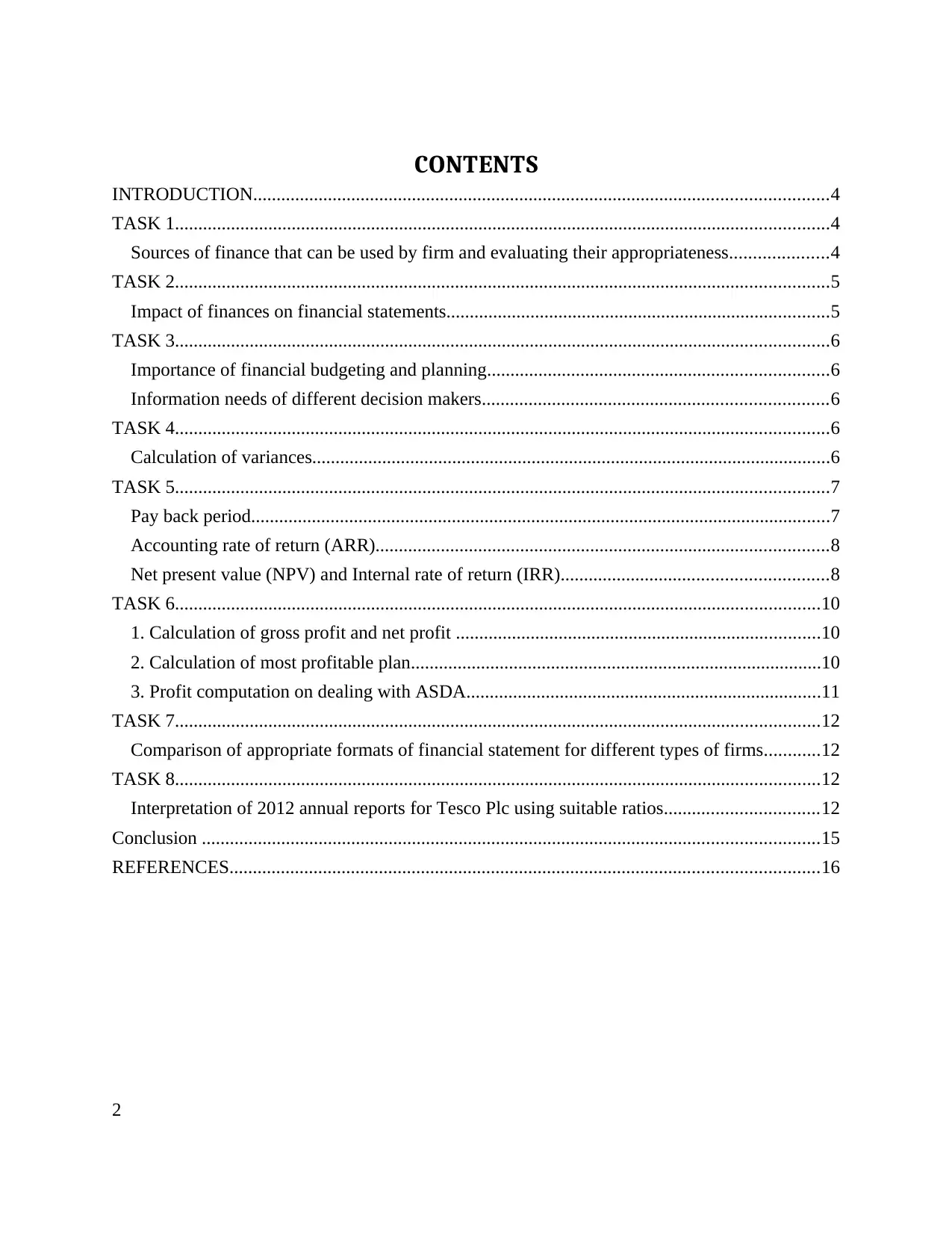
CONTENTS
INTRODUCTION...........................................................................................................................4
TASK 1............................................................................................................................................4
Sources of finance that can be used by firm and evaluating their appropriateness.....................4
TASK 2............................................................................................................................................5
Impact of finances on financial statements..................................................................................5
TASK 3............................................................................................................................................6
Importance of financial budgeting and planning.........................................................................6
Information needs of different decision makers..........................................................................6
TASK 4............................................................................................................................................6
Calculation of variances...............................................................................................................6
TASK 5............................................................................................................................................7
Pay back period............................................................................................................................7
Accounting rate of return (ARR).................................................................................................8
Net present value (NPV) and Internal rate of return (IRR).........................................................8
TASK 6..........................................................................................................................................10
1. Calculation of gross profit and net profit ..............................................................................10
2. Calculation of most profitable plan........................................................................................10
3. Profit computation on dealing with ASDA............................................................................11
TASK 7..........................................................................................................................................12
Comparison of appropriate formats of financial statement for different types of firms............12
TASK 8..........................................................................................................................................12
Interpretation of 2012 annual reports for Tesco Plc using suitable ratios.................................12
Conclusion ....................................................................................................................................15
REFERENCES..............................................................................................................................16
2
INTRODUCTION...........................................................................................................................4
TASK 1............................................................................................................................................4
Sources of finance that can be used by firm and evaluating their appropriateness.....................4
TASK 2............................................................................................................................................5
Impact of finances on financial statements..................................................................................5
TASK 3............................................................................................................................................6
Importance of financial budgeting and planning.........................................................................6
Information needs of different decision makers..........................................................................6
TASK 4............................................................................................................................................6
Calculation of variances...............................................................................................................6
TASK 5............................................................................................................................................7
Pay back period............................................................................................................................7
Accounting rate of return (ARR).................................................................................................8
Net present value (NPV) and Internal rate of return (IRR).........................................................8
TASK 6..........................................................................................................................................10
1. Calculation of gross profit and net profit ..............................................................................10
2. Calculation of most profitable plan........................................................................................10
3. Profit computation on dealing with ASDA............................................................................11
TASK 7..........................................................................................................................................12
Comparison of appropriate formats of financial statement for different types of firms............12
TASK 8..........................................................................................................................................12
Interpretation of 2012 annual reports for Tesco Plc using suitable ratios.................................12
Conclusion ....................................................................................................................................15
REFERENCES..............................................................................................................................16
2
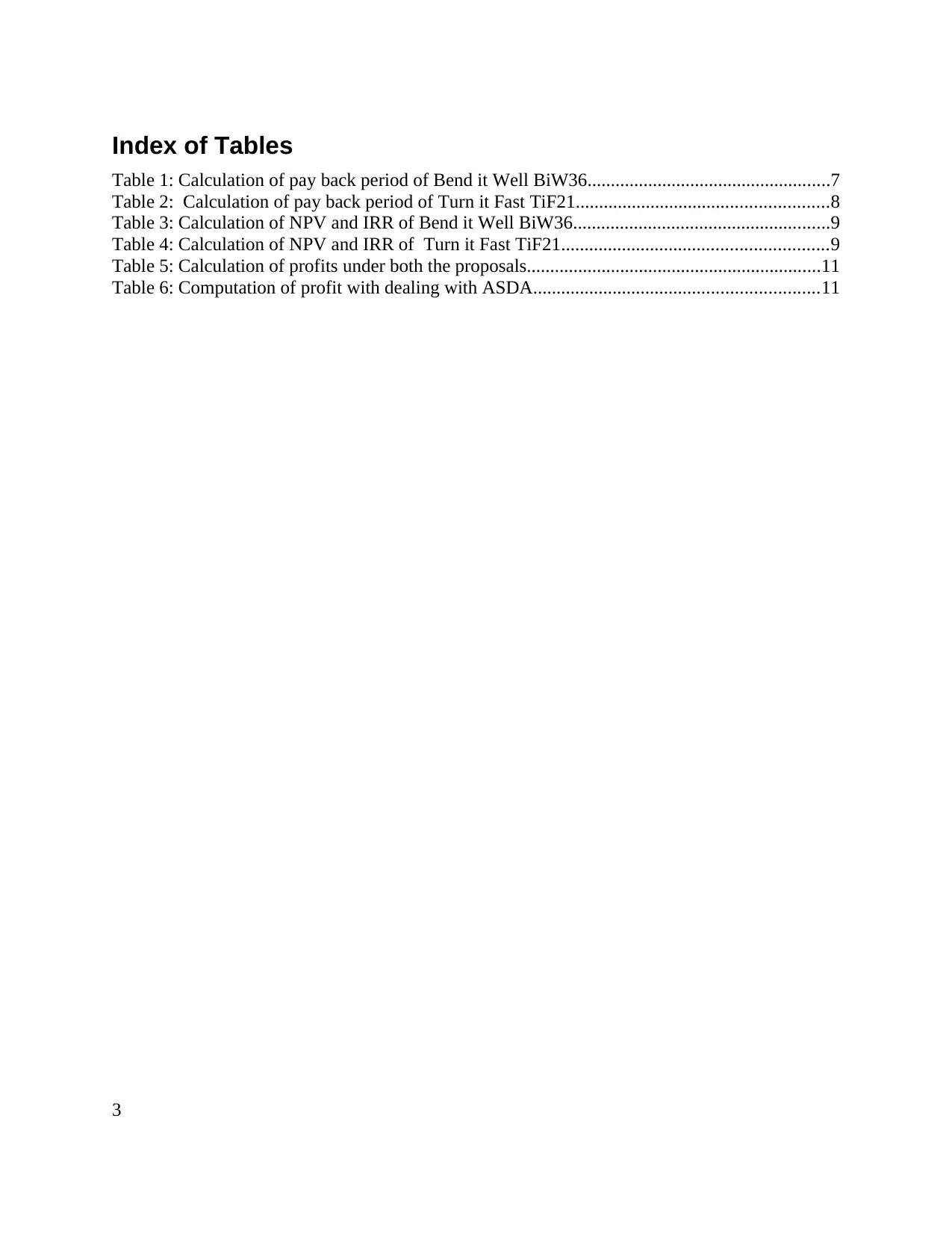
Index of Tables
Table 1: Calculation of pay back period of Bend it Well BiW36....................................................7
Table 2: Calculation of pay back period of Turn it Fast TiF21......................................................8
Table 3: Calculation of NPV and IRR of Bend it Well BiW36.......................................................9
Table 4: Calculation of NPV and IRR of Turn it Fast TiF21.........................................................9
Table 5: Calculation of profits under both the proposals...............................................................11
Table 6: Computation of profit with dealing with ASDA.............................................................11
3
Table 1: Calculation of pay back period of Bend it Well BiW36....................................................7
Table 2: Calculation of pay back period of Turn it Fast TiF21......................................................8
Table 3: Calculation of NPV and IRR of Bend it Well BiW36.......................................................9
Table 4: Calculation of NPV and IRR of Turn it Fast TiF21.........................................................9
Table 5: Calculation of profits under both the proposals...............................................................11
Table 6: Computation of profit with dealing with ASDA.............................................................11
3
⊘ This is a preview!⊘
Do you want full access?
Subscribe today to unlock all pages.

Trusted by 1+ million students worldwide
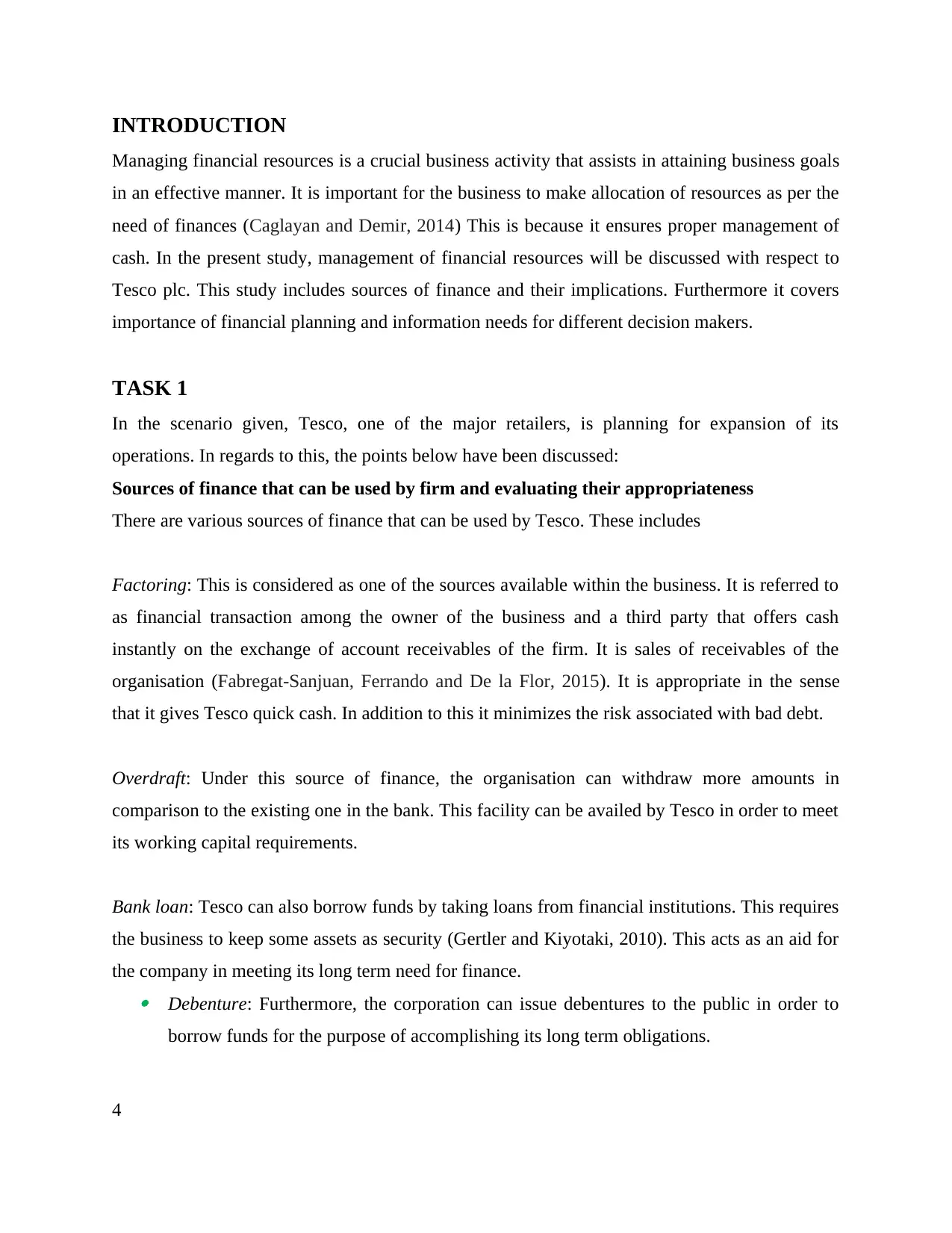
INTRODUCTION
Managing financial resources is a crucial business activity that assists in attaining business goals
in an effective manner. It is important for the business to make allocation of resources as per the
need of finances (Caglayan and Demir, 2014) This is because it ensures proper management of
cash. In the present study, management of financial resources will be discussed with respect to
Tesco plc. This study includes sources of finance and their implications. Furthermore it covers
importance of financial planning and information needs for different decision makers.
TASK 1
In the scenario given, Tesco, one of the major retailers, is planning for expansion of its
operations. In regards to this, the points below have been discussed:
Sources of finance that can be used by firm and evaluating their appropriateness
There are various sources of finance that can be used by Tesco. These includes
Factoring: This is considered as one of the sources available within the business. It is referred to
as financial transaction among the owner of the business and a third party that offers cash
instantly on the exchange of account receivables of the firm. It is sales of receivables of the
organisation (Fabregat-Sanjuan, Ferrando and De la Flor, 2015). It is appropriate in the sense
that it gives Tesco quick cash. In addition to this it minimizes the risk associated with bad debt.
Overdraft: Under this source of finance, the organisation can withdraw more amounts in
comparison to the existing one in the bank. This facility can be availed by Tesco in order to meet
its working capital requirements.
Bank loan: Tesco can also borrow funds by taking loans from financial institutions. This requires
the business to keep some assets as security (Gertler and Kiyotaki, 2010). This acts as an aid for
the company in meeting its long term need for finance. Debenture: Furthermore, the corporation can issue debentures to the public in order to
borrow funds for the purpose of accomplishing its long term obligations.
4
Managing financial resources is a crucial business activity that assists in attaining business goals
in an effective manner. It is important for the business to make allocation of resources as per the
need of finances (Caglayan and Demir, 2014) This is because it ensures proper management of
cash. In the present study, management of financial resources will be discussed with respect to
Tesco plc. This study includes sources of finance and their implications. Furthermore it covers
importance of financial planning and information needs for different decision makers.
TASK 1
In the scenario given, Tesco, one of the major retailers, is planning for expansion of its
operations. In regards to this, the points below have been discussed:
Sources of finance that can be used by firm and evaluating their appropriateness
There are various sources of finance that can be used by Tesco. These includes
Factoring: This is considered as one of the sources available within the business. It is referred to
as financial transaction among the owner of the business and a third party that offers cash
instantly on the exchange of account receivables of the firm. It is sales of receivables of the
organisation (Fabregat-Sanjuan, Ferrando and De la Flor, 2015). It is appropriate in the sense
that it gives Tesco quick cash. In addition to this it minimizes the risk associated with bad debt.
Overdraft: Under this source of finance, the organisation can withdraw more amounts in
comparison to the existing one in the bank. This facility can be availed by Tesco in order to meet
its working capital requirements.
Bank loan: Tesco can also borrow funds by taking loans from financial institutions. This requires
the business to keep some assets as security (Gertler and Kiyotaki, 2010). This acts as an aid for
the company in meeting its long term need for finance. Debenture: Furthermore, the corporation can issue debentures to the public in order to
borrow funds for the purpose of accomplishing its long term obligations.
4
Paraphrase This Document
Need a fresh take? Get an instant paraphrase of this document with our AI Paraphraser

Shares: Issue of shares is considered as a permanent source of capital for the business.
With this, the firm can gain financial resources from the general public by means of
issuing them shares.
There are various implications associated with different sources of finance. In case of
overdraft and bank loans, timely payments need to be made to the financial institution otherwise
legal actions can be taken against the company and it can be declared bankrupt (Shul'ga, 2014).
In addition to this issue of shares and debentures requires Tesco to make payment of dividend on
time. If the payment is not made, this forces the appropriate people to take legal action against
the firm.
TASK 2
Impact of finances on financial statements
According to the scenario, the company wishes to buy a warehouse costing £300,000. It is
considering debenture of a share issue for this purpose.
Debenture issue: The rate of interest on debenture is 4% and must be repaid within 25 years.
Hence, it will impose a financial cost of £12000 each year in the form of interest. In the
profitability statement, it will be shown as business expenses hence, profits will be reduced.
However, in the balance sheet, it will be subtracted from the cash balance while the amount of
debt taken amounted to £300,000 will be added in cash. Another point is, it is a long term loan
hence, it will be shown as a long term debt under the liability side. Furthermore, as it shows in
the assignment brief, the corporation tax rate is 20% and the interest payment on debt is
considered as an allowable expense. Therefore, it will reduce tax obligations and increase profits
for the organisation.
5
With this, the firm can gain financial resources from the general public by means of
issuing them shares.
There are various implications associated with different sources of finance. In case of
overdraft and bank loans, timely payments need to be made to the financial institution otherwise
legal actions can be taken against the company and it can be declared bankrupt (Shul'ga, 2014).
In addition to this issue of shares and debentures requires Tesco to make payment of dividend on
time. If the payment is not made, this forces the appropriate people to take legal action against
the firm.
TASK 2
Impact of finances on financial statements
According to the scenario, the company wishes to buy a warehouse costing £300,000. It is
considering debenture of a share issue for this purpose.
Debenture issue: The rate of interest on debenture is 4% and must be repaid within 25 years.
Hence, it will impose a financial cost of £12000 each year in the form of interest. In the
profitability statement, it will be shown as business expenses hence, profits will be reduced.
However, in the balance sheet, it will be subtracted from the cash balance while the amount of
debt taken amounted to £300,000 will be added in cash. Another point is, it is a long term loan
hence, it will be shown as a long term debt under the liability side. Furthermore, as it shows in
the assignment brief, the corporation tax rate is 20% and the interest payment on debt is
considered as an allowable expense. Therefore, it will reduce tax obligations and increase profits
for the organisation.
5
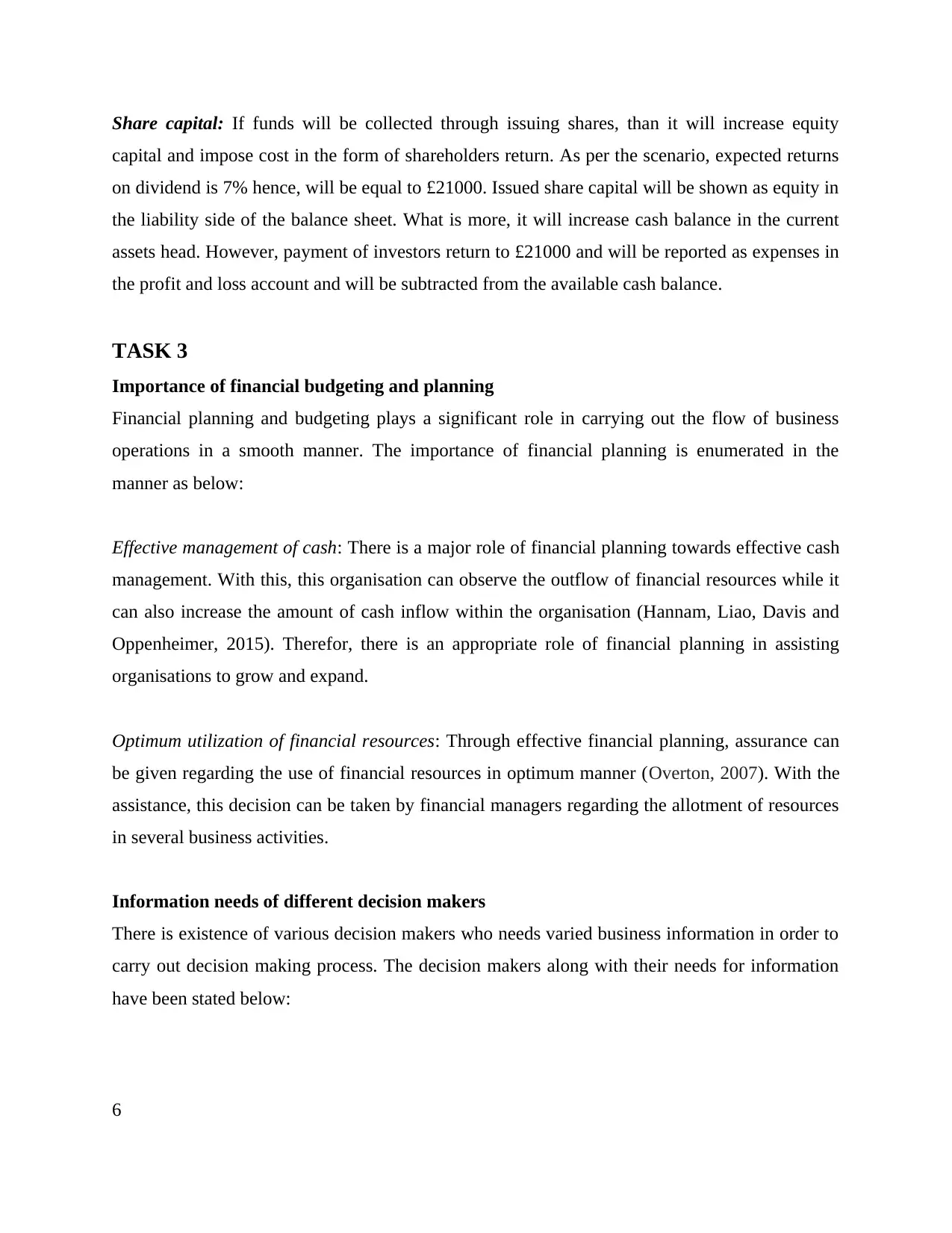
Share capital: If funds will be collected through issuing shares, than it will increase equity
capital and impose cost in the form of shareholders return. As per the scenario, expected returns
on dividend is 7% hence, will be equal to £21000. Issued share capital will be shown as equity in
the liability side of the balance sheet. What is more, it will increase cash balance in the current
assets head. However, payment of investors return to £21000 and will be reported as expenses in
the profit and loss account and will be subtracted from the available cash balance.
TASK 3
Importance of financial budgeting and planning
Financial planning and budgeting plays a significant role in carrying out the flow of business
operations in a smooth manner. The importance of financial planning is enumerated in the
manner as below:
Effective management of cash: There is a major role of financial planning towards effective cash
management. With this, this organisation can observe the outflow of financial resources while it
can also increase the amount of cash inflow within the organisation (Hannam, Liao, Davis and
Oppenheimer, 2015). Therefor, there is an appropriate role of financial planning in assisting
organisations to grow and expand.
Optimum utilization of financial resources: Through effective financial planning, assurance can
be given regarding the use of financial resources in optimum manner (Overton, 2007). With the
assistance, this decision can be taken by financial managers regarding the allotment of resources
in several business activities.
Information needs of different decision makers
There is existence of various decision makers who needs varied business information in order to
carry out decision making process. The decision makers along with their needs for information
have been stated below:
6
capital and impose cost in the form of shareholders return. As per the scenario, expected returns
on dividend is 7% hence, will be equal to £21000. Issued share capital will be shown as equity in
the liability side of the balance sheet. What is more, it will increase cash balance in the current
assets head. However, payment of investors return to £21000 and will be reported as expenses in
the profit and loss account and will be subtracted from the available cash balance.
TASK 3
Importance of financial budgeting and planning
Financial planning and budgeting plays a significant role in carrying out the flow of business
operations in a smooth manner. The importance of financial planning is enumerated in the
manner as below:
Effective management of cash: There is a major role of financial planning towards effective cash
management. With this, this organisation can observe the outflow of financial resources while it
can also increase the amount of cash inflow within the organisation (Hannam, Liao, Davis and
Oppenheimer, 2015). Therefor, there is an appropriate role of financial planning in assisting
organisations to grow and expand.
Optimum utilization of financial resources: Through effective financial planning, assurance can
be given regarding the use of financial resources in optimum manner (Overton, 2007). With the
assistance, this decision can be taken by financial managers regarding the allotment of resources
in several business activities.
Information needs of different decision makers
There is existence of various decision makers who needs varied business information in order to
carry out decision making process. The decision makers along with their needs for information
have been stated below:
6
⊘ This is a preview!⊘
Do you want full access?
Subscribe today to unlock all pages.

Trusted by 1+ million students worldwide
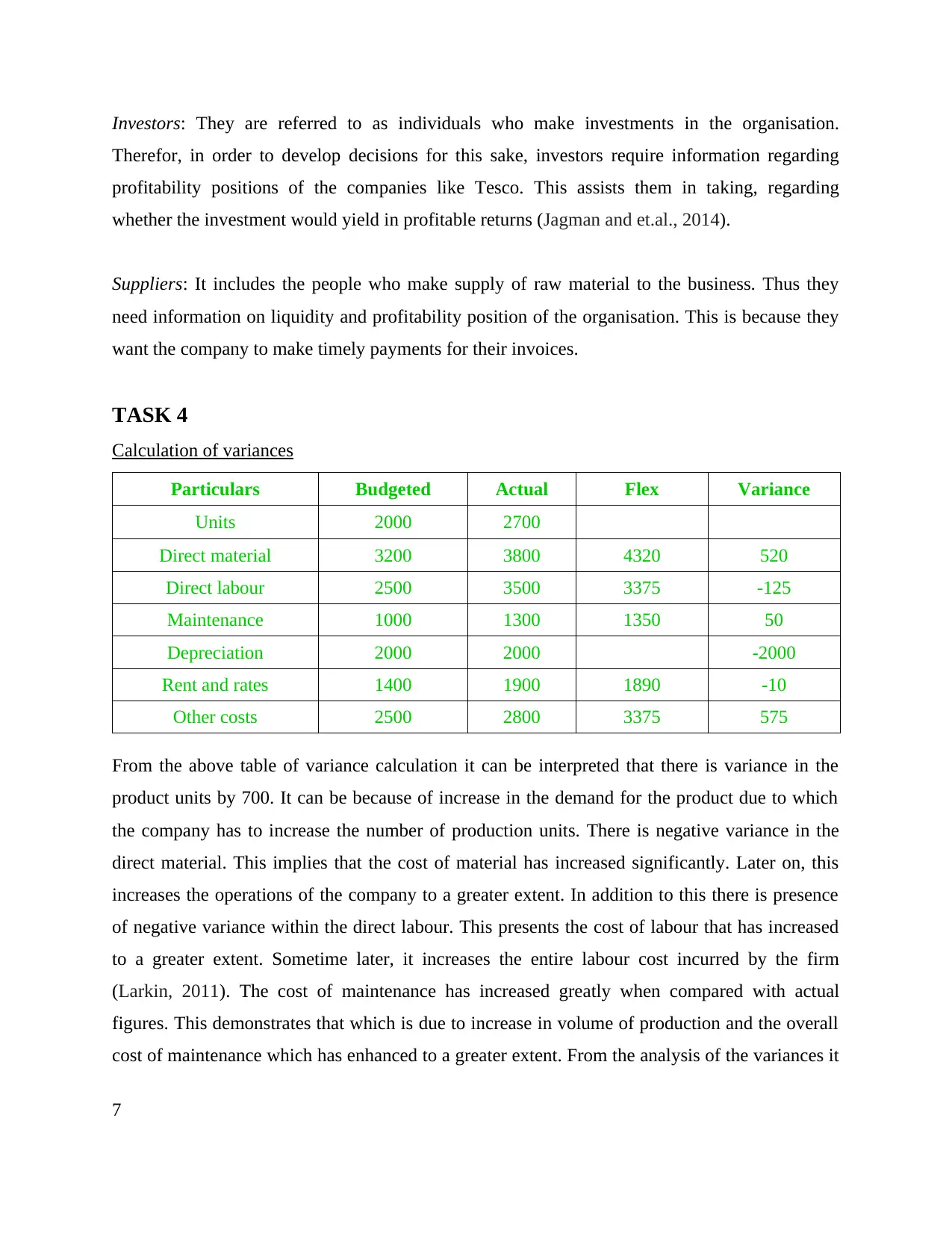
Investors: They are referred to as individuals who make investments in the organisation.
Therefor, in order to develop decisions for this sake, investors require information regarding
profitability positions of the companies like Tesco. This assists them in taking, regarding
whether the investment would yield in profitable returns (Jagman and et.al., 2014).
Suppliers: It includes the people who make supply of raw material to the business. Thus they
need information on liquidity and profitability position of the organisation. This is because they
want the company to make timely payments for their invoices.
TASK 4
Calculation of variances
Particulars Budgeted Actual Flex Variance
Units 2000 2700
Direct material 3200 3800 4320 520
Direct labour 2500 3500 3375 -125
Maintenance 1000 1300 1350 50
Depreciation 2000 2000 -2000
Rent and rates 1400 1900 1890 -10
Other costs 2500 2800 3375 575
From the above table of variance calculation it can be interpreted that there is variance in the
product units by 700. It can be because of increase in the demand for the product due to which
the company has to increase the number of production units. There is negative variance in the
direct material. This implies that the cost of material has increased significantly. Later on, this
increases the operations of the company to a greater extent. In addition to this there is presence
of negative variance within the direct labour. This presents the cost of labour that has increased
to a greater extent. Sometime later, it increases the entire labour cost incurred by the firm
(Larkin, 2011). The cost of maintenance has increased greatly when compared with actual
figures. This demonstrates that which is due to increase in volume of production and the overall
cost of maintenance which has enhanced to a greater extent. From the analysis of the variances it
7
Therefor, in order to develop decisions for this sake, investors require information regarding
profitability positions of the companies like Tesco. This assists them in taking, regarding
whether the investment would yield in profitable returns (Jagman and et.al., 2014).
Suppliers: It includes the people who make supply of raw material to the business. Thus they
need information on liquidity and profitability position of the organisation. This is because they
want the company to make timely payments for their invoices.
TASK 4
Calculation of variances
Particulars Budgeted Actual Flex Variance
Units 2000 2700
Direct material 3200 3800 4320 520
Direct labour 2500 3500 3375 -125
Maintenance 1000 1300 1350 50
Depreciation 2000 2000 -2000
Rent and rates 1400 1900 1890 -10
Other costs 2500 2800 3375 575
From the above table of variance calculation it can be interpreted that there is variance in the
product units by 700. It can be because of increase in the demand for the product due to which
the company has to increase the number of production units. There is negative variance in the
direct material. This implies that the cost of material has increased significantly. Later on, this
increases the operations of the company to a greater extent. In addition to this there is presence
of negative variance within the direct labour. This presents the cost of labour that has increased
to a greater extent. Sometime later, it increases the entire labour cost incurred by the firm
(Larkin, 2011). The cost of maintenance has increased greatly when compared with actual
figures. This demonstrates that which is due to increase in volume of production and the overall
cost of maintenance which has enhanced to a greater extent. From the analysis of the variances it
7
Paraphrase This Document
Need a fresh take? Get an instant paraphrase of this document with our AI Paraphraser
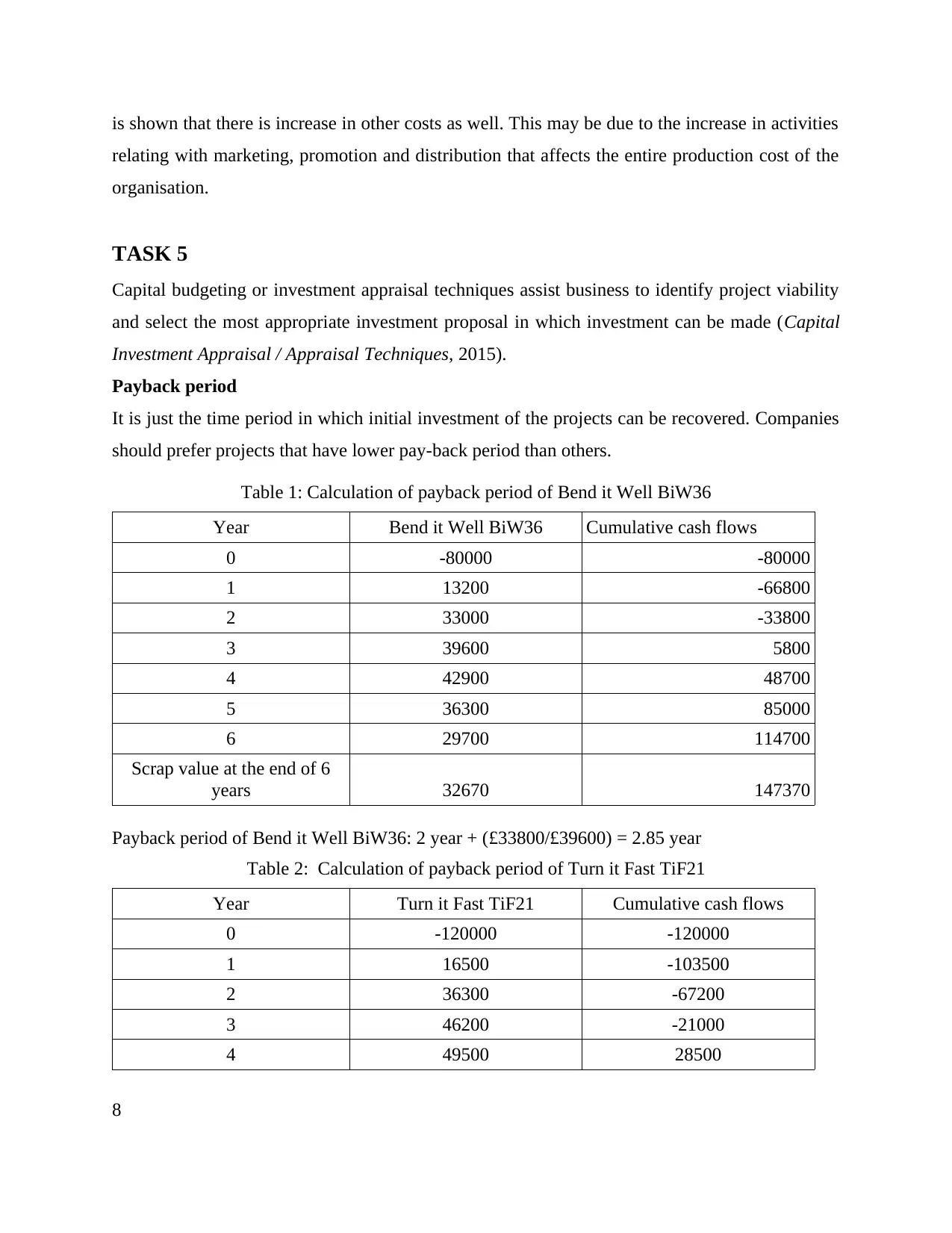
is shown that there is increase in other costs as well. This may be due to the increase in activities
relating with marketing, promotion and distribution that affects the entire production cost of the
organisation.
TASK 5
Capital budgeting or investment appraisal techniques assist business to identify project viability
and select the most appropriate investment proposal in which investment can be made (Capital
Investment Appraisal / Appraisal Techniques, 2015).
Payback period
It is just the time period in which initial investment of the projects can be recovered. Companies
should prefer projects that have lower pay-back period than others.
Table 1: Calculation of payback period of Bend it Well BiW36
Year Bend it Well BiW36 Cumulative cash flows
0 -80000 -80000
1 13200 -66800
2 33000 -33800
3 39600 5800
4 42900 48700
5 36300 85000
6 29700 114700
Scrap value at the end of 6
years 32670 147370
Payback period of Bend it Well BiW36: 2 year + (£33800/£39600) = 2.85 year
Table 2: Calculation of payback period of Turn it Fast TiF21
Year Turn it Fast TiF21 Cumulative cash flows
0 -120000 -120000
1 16500 -103500
2 36300 -67200
3 46200 -21000
4 49500 28500
8
relating with marketing, promotion and distribution that affects the entire production cost of the
organisation.
TASK 5
Capital budgeting or investment appraisal techniques assist business to identify project viability
and select the most appropriate investment proposal in which investment can be made (Capital
Investment Appraisal / Appraisal Techniques, 2015).
Payback period
It is just the time period in which initial investment of the projects can be recovered. Companies
should prefer projects that have lower pay-back period than others.
Table 1: Calculation of payback period of Bend it Well BiW36
Year Bend it Well BiW36 Cumulative cash flows
0 -80000 -80000
1 13200 -66800
2 33000 -33800
3 39600 5800
4 42900 48700
5 36300 85000
6 29700 114700
Scrap value at the end of 6
years 32670 147370
Payback period of Bend it Well BiW36: 2 year + (£33800/£39600) = 2.85 year
Table 2: Calculation of payback period of Turn it Fast TiF21
Year Turn it Fast TiF21 Cumulative cash flows
0 -120000 -120000
1 16500 -103500
2 36300 -67200
3 46200 -21000
4 49500 28500
8

5 42900 71400
6 26400 97800
Scrap value at the end of 6
years 30492 128292
Payback period of Turn it Fast TiF21 = 3 year + (£21000/£49500) = 3.42 year
Accounting rate of return (ARR)
It measures the rate of potential profits that can be generated over the initial project cost.
High ARR project seems to be more beneficial for the organisation because it provides greater
return.
ARR = Average annual profits/Inital investment*100
Bend it Well BiW36: (£227370/6)/(£80000)*100 = 47.37%
Turn it Fast TiF21: (£248292/6)/(£120000)*100 = 34.48%
Net present value (NPV) and Internal rate of return (IRR)
Both the methods are discounted methods and consider time and value of money. In NPV
method, all the associated future cash inflows will be discounted using a discount rate while the
excess of total discounted cash inflows over initial cash outlay is termed as NPV. Besides this,
IRR is the discount rate at which NPV of the project will be nil.
Table 3: Calculation of NPV and IRR of Bend it Well BiW36
Year Bend it Well BiW36 Discounted value
Discounted cash
flows
0 -80000 1 -80000
1 13200 0.9259259259 12222.22
2 33000 0.8573388203 28292.18
3 39600 0.793832241 31435.76
4 42900 0.7350298528 31532.78
5 36300 0.680583197 24705.17
6 29700 0.6301696269 18716.04
Scrap value at the end
of 6 years 32670 0.630169627 20587.64
Total 31.82% 87491.790406391
9
6 26400 97800
Scrap value at the end of 6
years 30492 128292
Payback period of Turn it Fast TiF21 = 3 year + (£21000/£49500) = 3.42 year
Accounting rate of return (ARR)
It measures the rate of potential profits that can be generated over the initial project cost.
High ARR project seems to be more beneficial for the organisation because it provides greater
return.
ARR = Average annual profits/Inital investment*100
Bend it Well BiW36: (£227370/6)/(£80000)*100 = 47.37%
Turn it Fast TiF21: (£248292/6)/(£120000)*100 = 34.48%
Net present value (NPV) and Internal rate of return (IRR)
Both the methods are discounted methods and consider time and value of money. In NPV
method, all the associated future cash inflows will be discounted using a discount rate while the
excess of total discounted cash inflows over initial cash outlay is termed as NPV. Besides this,
IRR is the discount rate at which NPV of the project will be nil.
Table 3: Calculation of NPV and IRR of Bend it Well BiW36
Year Bend it Well BiW36 Discounted value
Discounted cash
flows
0 -80000 1 -80000
1 13200 0.9259259259 12222.22
2 33000 0.8573388203 28292.18
3 39600 0.793832241 31435.76
4 42900 0.7350298528 31532.78
5 36300 0.680583197 24705.17
6 29700 0.6301696269 18716.04
Scrap value at the end
of 6 years 32670 0.630169627 20587.64
Total 31.82% 87491.790406391
9
⊘ This is a preview!⊘
Do you want full access?
Subscribe today to unlock all pages.

Trusted by 1+ million students worldwide

Table 4: Calculation of NPV and IRR of Turn it Fast TiF21
Year Turn it Fast TiF21 Discounted value
Discounted cash
flows
0 -120000 1 -120000
1 16500 0.9259259259 15277.78
2 36300 0.8573388203 31121.4
3 46200 0.793832241 36675.05
4 49500 0.7350298528 36383.98
5 42900 0.680583197 29197.02
6 26400 0.6301696269 16636.47
Scrap value at the end
of 6 years 30492 0.6301696269 19215.13
Total 21.17% 64506.83
Interpretation: From the basis of above computation, it became clear that the company should
adopt Bend it Well BiW36. Lower PP, high ARR, IRR and NPV are the reasons behind this
decision.
TASK 6
1. Calculation of gross profit and net profit
As per the scenario, per unit cost and selling price are £5.60 and £15.50 respectively. However,
annual fixed overhead is amounted to £79000. Gross profit is the excess of the total sales
revenue over the cost of sales. However, net profit is the excess of total revenues, over all the
fixed as well as variable overheads. For the given scenario, it has been calculated for 49500 units
and 39600 units as follows:
Particulars Amount Amount
Sales units 39600 49500
Sales 613,800 767,250
Less: Cost of sales 221,760 277,200
Gross profit 392,040 490,050
Less; Annual fixed overheads 79,000 79,000
10
Year Turn it Fast TiF21 Discounted value
Discounted cash
flows
0 -120000 1 -120000
1 16500 0.9259259259 15277.78
2 36300 0.8573388203 31121.4
3 46200 0.793832241 36675.05
4 49500 0.7350298528 36383.98
5 42900 0.680583197 29197.02
6 26400 0.6301696269 16636.47
Scrap value at the end
of 6 years 30492 0.6301696269 19215.13
Total 21.17% 64506.83
Interpretation: From the basis of above computation, it became clear that the company should
adopt Bend it Well BiW36. Lower PP, high ARR, IRR and NPV are the reasons behind this
decision.
TASK 6
1. Calculation of gross profit and net profit
As per the scenario, per unit cost and selling price are £5.60 and £15.50 respectively. However,
annual fixed overhead is amounted to £79000. Gross profit is the excess of the total sales
revenue over the cost of sales. However, net profit is the excess of total revenues, over all the
fixed as well as variable overheads. For the given scenario, it has been calculated for 49500 units
and 39600 units as follows:
Particulars Amount Amount
Sales units 39600 49500
Sales 613,800 767,250
Less: Cost of sales 221,760 277,200
Gross profit 392,040 490,050
Less; Annual fixed overheads 79,000 79,000
10
Paraphrase This Document
Need a fresh take? Get an instant paraphrase of this document with our AI Paraphraser
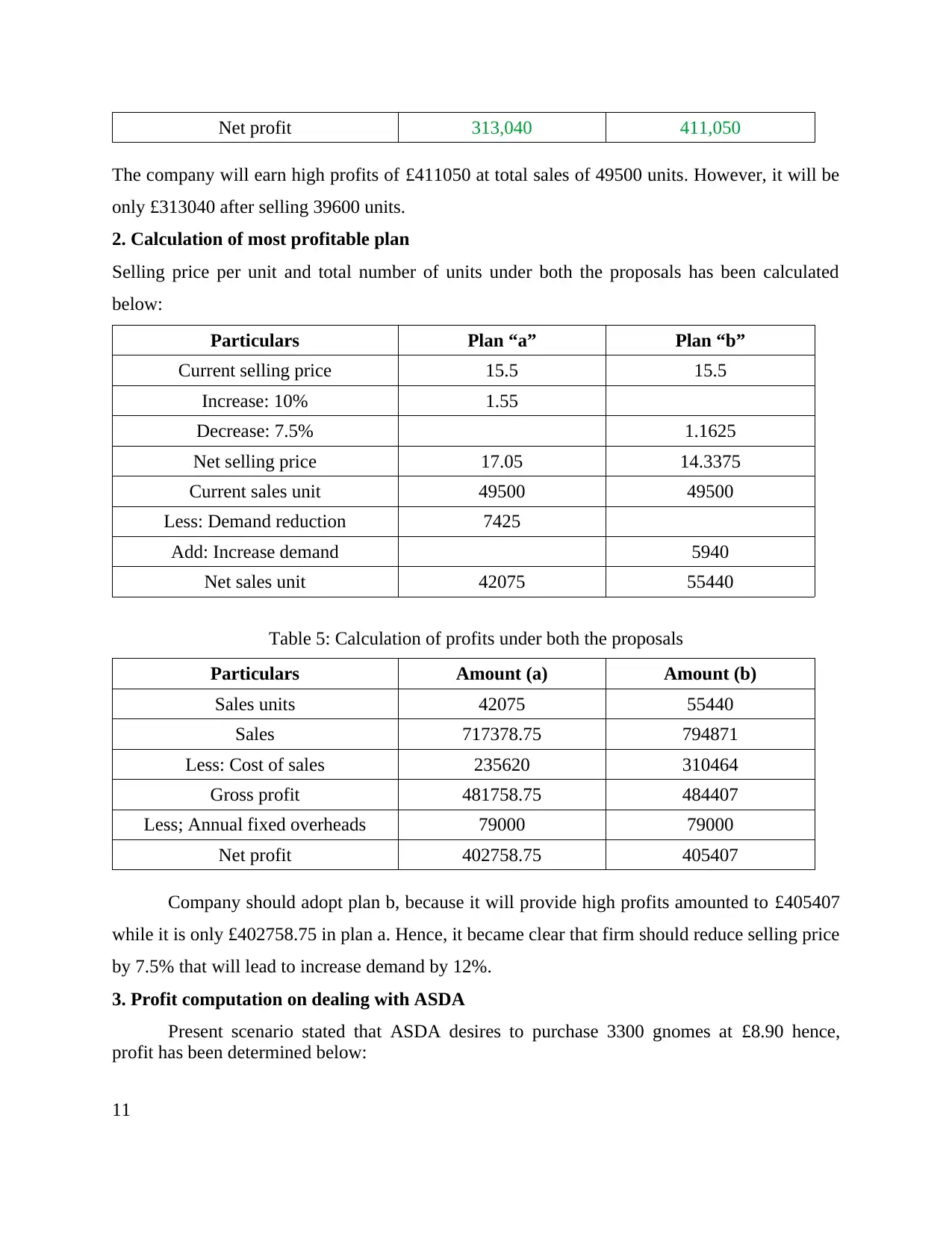
Net profit 313,040 411,050
The company will earn high profits of £411050 at total sales of 49500 units. However, it will be
only £313040 after selling 39600 units.
2. Calculation of most profitable plan
Selling price per unit and total number of units under both the proposals has been calculated
below:
Particulars Plan “a” Plan “b”
Current selling price 15.5 15.5
Increase: 10% 1.55
Decrease: 7.5% 1.1625
Net selling price 17.05 14.3375
Current sales unit 49500 49500
Less: Demand reduction 7425
Add: Increase demand 5940
Net sales unit 42075 55440
Table 5: Calculation of profits under both the proposals
Particulars Amount (a) Amount (b)
Sales units 42075 55440
Sales 717378.75 794871
Less: Cost of sales 235620 310464
Gross profit 481758.75 484407
Less; Annual fixed overheads 79000 79000
Net profit 402758.75 405407
Company should adopt plan b, because it will provide high profits amounted to £405407
while it is only £402758.75 in plan a. Hence, it became clear that firm should reduce selling price
by 7.5% that will lead to increase demand by 12%.
3. Profit computation on dealing with ASDA
Present scenario stated that ASDA desires to purchase 3300 gnomes at £8.90 hence,
profit has been determined below:
11
The company will earn high profits of £411050 at total sales of 49500 units. However, it will be
only £313040 after selling 39600 units.
2. Calculation of most profitable plan
Selling price per unit and total number of units under both the proposals has been calculated
below:
Particulars Plan “a” Plan “b”
Current selling price 15.5 15.5
Increase: 10% 1.55
Decrease: 7.5% 1.1625
Net selling price 17.05 14.3375
Current sales unit 49500 49500
Less: Demand reduction 7425
Add: Increase demand 5940
Net sales unit 42075 55440
Table 5: Calculation of profits under both the proposals
Particulars Amount (a) Amount (b)
Sales units 42075 55440
Sales 717378.75 794871
Less: Cost of sales 235620 310464
Gross profit 481758.75 484407
Less; Annual fixed overheads 79000 79000
Net profit 402758.75 405407
Company should adopt plan b, because it will provide high profits amounted to £405407
while it is only £402758.75 in plan a. Hence, it became clear that firm should reduce selling price
by 7.5% that will lead to increase demand by 12%.
3. Profit computation on dealing with ASDA
Present scenario stated that ASDA desires to purchase 3300 gnomes at £8.90 hence,
profit has been determined below:
11

Table 6: Computation of profit with dealing with ASDA
Particulars Amount Previous sales Total profit
Sales units 3300 49500 52800
Selling price 8.9 15.5
Sales 29370 767250 796620
Less: Cost of sales 18480 277200 295680
Gross profit 10890 490050 500940
Less; Annual fixed
overheads 79000 79000
Net profit 10890 411050 421940
Hence, it can be seen that if the company sells products to ASDA than it will provide advantage
of high profits by £10890. However, its disadvantage is, the selling price that is £8.90 is
significantly lower than the current market selling price of £15.50. Hence, it will affect profits in
an adverse manner.
TASK 7
Comparison of appropriate formats of financial statements for different types of firms
There is presence of various formats of financial statements that are being prepared by various
businesses. This includes the following:
Sole-traders: It is referred to as the types of business that prepares simple statements of profit
and loss. It is the kind of organisation that is owned and managed by single individuals (Murphy,
and Yetmar, 2010). Therefore, they are not required to reveal their accounts to others and enjoy
full profit margins and incur entire loss from the business transactions.
Partnership: In contrast to this partnership is a business that is carried out by two or more
individuals. This type of firm develops cash flow statements, balance sheets, as well as income
statement (Orlitzky, Schmidt and Rynes, 2003). In addition to this it also prepares partners with
12
Particulars Amount Previous sales Total profit
Sales units 3300 49500 52800
Selling price 8.9 15.5
Sales 29370 767250 796620
Less: Cost of sales 18480 277200 295680
Gross profit 10890 490050 500940
Less; Annual fixed
overheads 79000 79000
Net profit 10890 411050 421940
Hence, it can be seen that if the company sells products to ASDA than it will provide advantage
of high profits by £10890. However, its disadvantage is, the selling price that is £8.90 is
significantly lower than the current market selling price of £15.50. Hence, it will affect profits in
an adverse manner.
TASK 7
Comparison of appropriate formats of financial statements for different types of firms
There is presence of various formats of financial statements that are being prepared by various
businesses. This includes the following:
Sole-traders: It is referred to as the types of business that prepares simple statements of profit
and loss. It is the kind of organisation that is owned and managed by single individuals (Murphy,
and Yetmar, 2010). Therefore, they are not required to reveal their accounts to others and enjoy
full profit margins and incur entire loss from the business transactions.
Partnership: In contrast to this partnership is a business that is carried out by two or more
individuals. This type of firm develops cash flow statements, balance sheets, as well as income
statement (Orlitzky, Schmidt and Rynes, 2003). In addition to this it also prepares partners with
12
⊘ This is a preview!⊘
Do you want full access?
Subscribe today to unlock all pages.

Trusted by 1+ million students worldwide
1 out of 16
Related Documents
Your All-in-One AI-Powered Toolkit for Academic Success.
+13062052269
info@desklib.com
Available 24*7 on WhatsApp / Email
![[object Object]](/_next/static/media/star-bottom.7253800d.svg)
Unlock your academic potential
Copyright © 2020–2025 A2Z Services. All Rights Reserved. Developed and managed by ZUCOL.





